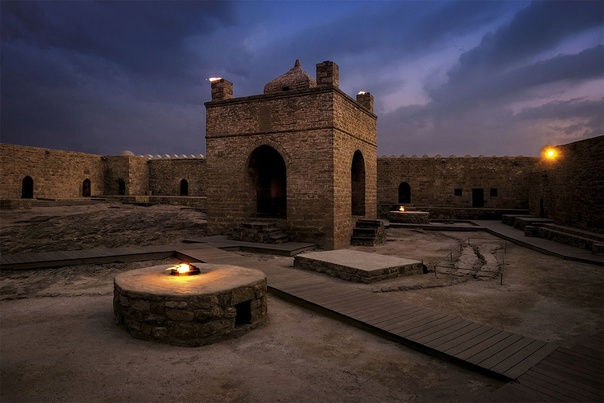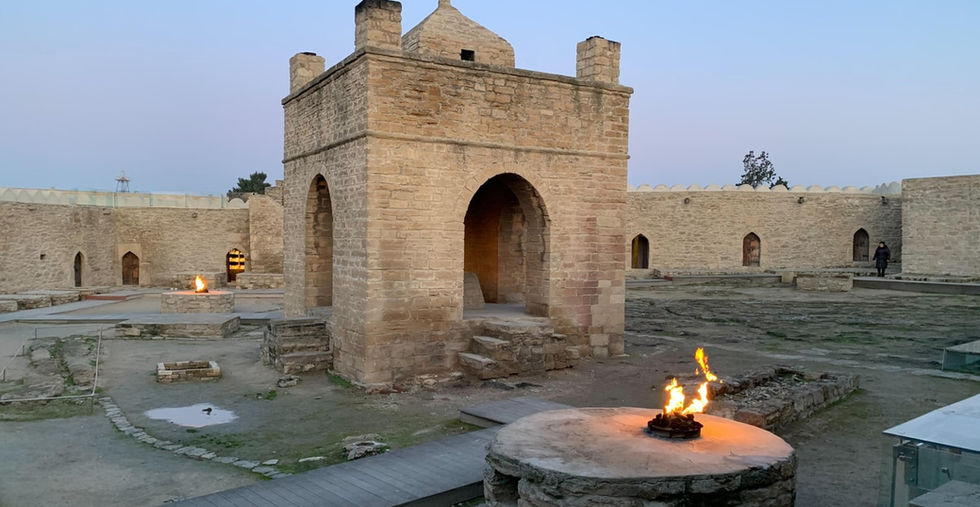Information About the Ateshgah Temple
The Ateshgah Temple, located in the Surakhani district of Baku, Azerbaijan, is a unique historical and religious monument. Built on natural gas vents that created eternal flames, the temple has been known as a center of religion and culture since ancient times. Ateshgah has been associated with both Zoroastrianism and Hinduism, serving as a place of worship during different historical periods.
1. History
The Ateshgah Temple was primarily constructed in the 17th-18th centuries, although the site has been a sacred place for Zoroastrians since ancient times.
Over centuries, people from various nations and religions, particularly Zoroastrians, Hindus, and others, visited this site as a pilgrimage destination.
The name “Ateshgah” derives from the Persian word "Atesh," meaning "fire," translating to "House of Fire."
2. Architecture of the Temple
Ateshgah has a pentagonal structure with a central sacred fire altar.
Surrounding the altar are cells and chambers that were used by worshippers and pilgrims.
The walls of the temple contain inscriptions in Sanskrit and Persian, as well as religious symbols.
The main fire altar, located at the center of the complex, was fueled by natural gas leaks in ancient times, resulting in a continuous flame.
3. Religious Significance
Zoroastrianism: Ateshgah is recognized as a Zoroastrian fire temple. Fire is a sacred element in Zoroastrianism, and this site served as a major religious center for their rituals.
Hinduism: In the 17th and 18th centuries, Hindu merchants and pilgrims from India conducted their religious ceremonies here. Some sections of the temple are decorated with symbols and carvings associated with Hindu traditions.
Its status as an international pilgrimage site was largely due to its natural eternal flames and strategic location.
4. Unique Features of Ateshgah
Ateshgah is one of the rare examples of temples built over natural eternal flames caused by underground gas leaks.
In the 19th century, the flames were extinguished as the natural gas began to be used for industrial purposes. Today, the central altar is ignited artificially for demonstration purposes.
5. Modern Era and Museum
In 1975, Ateshgah was turned into a state historical and architectural reserve and is now a popular tourist attraction in Azerbaijan.
The site features exhibits showcasing ancient religious rituals, the history and architecture of the temple, and the lifestyle of pilgrims.
Ateshgah was included on the UNESCO Tentative World Heritage List in 1998 for its cultural and historical significance.
6. Cultural Significance
Ateshgah is a symbol of Azerbaijan’s ancient religious and cultural heritage.
It has been a melting pot for different cultures and religions over centuries, reflecting Azerbaijan’s long history of multiculturalism and tolerance.
The Ateshgah Temple is one of Azerbaijan’s most unique historical monuments. As a site that has attracted visitors for centuries, it holds great importance both historically and spiritually, offering a glimpse into the rich cultural heritage of the region.

























